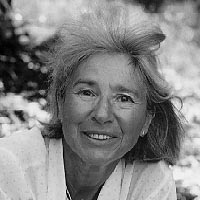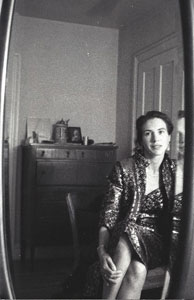Verena Huber-Dyson
Verena Huber-Dyson

In 1997, my son George Dyson handed me a batch of comments dated Oct. 29, 1998—Edge #29 ("What Are Numbers, Really? A Cerebral Basis For Number Sense"), by Stanislas Dehaene and Nov. 7—Edge #30 (the subsequent Reality Club discussion) by a group of Edge researchers. I read it all with great interest, and then my head started spinning.
Anyone interested in the psychology (or even psycho-pathology) of mathematical activity could have had fun watching me these last weeks. And now here I am with an octopus of inconclusive ramblings on the Foundations bulging my in "essays" file and a proliferation of hieroglyphs in the one entitled "doodles." It is so much easier to do mathematics than to philosophize about it. My group theoretic musings, the doodles, have been a refuge all my life.
VERENA HUBER-DYSON, mathematician and logician, died yesterday in Bellingham, Washington, at the age of 92. She was Emeritus Professor of the Philosophy Department, University of Calgary, Alberta.
Born in Naples and raised in Athens until 1940, she joined the Institute for Advanced Study as a visiting member of the School of Mathematics in 1948 after obtaining her PhD from the University of Zürich with a thesis in finite group theory under Andreas Speiser in 1947. After teaching positions at Cornell University, Goucher College, San Jose State University, Adelphi University, UCLA, Mills College, and UC Berkeley (where she was a member of Tarski's Group in Logic and the Methodology of Science), she obtained tenure as an associate professor in the Mathematics department of the University of Illinois.
From 1973 to 1988, she was a professor in the Philosophy department of the University of Calgary, Alberta Canada, where she taught graduate courses on the Foundations of Mathematics and the Philosophy and Methodology of the sciences. Her research, on the interface between Algebra and Logic, (Tarski and Novosibirsk Style) is concerned with undecidability in Group theory.
She is the author of a monograph, Gödel's theorems: a workbook on formalization (Teubner, 1991) based on her experience of teaching graduate courses and seminars on mathematical logic, formalization and its limitations to mathematics, philosophy and interdisciplinary students at the Universities of Calgary, Zürich and Monash. Verena Huber-Dyson's Edge Bio page
VHD on Edge:
GÖDEL IN A NUTSHELL
By Verena Huber-Dyson [ 5.13.06 ]
The essence of Gödel's incompleteness theorem is that you cannot have both completeness and consistency. A bold anthropomorphic conclusion is that there are three types of people; those that must have answers to everything; those that panic in the face of inconsistencies; and those that plod along taking the gaps of incompleteness as well as the clashes of inconsistencies in stride if they notice them at all, or else they succumb to the tragedy of the human condition. (Continue...)
GÖDEL AND THE NATURE OF MATHEMATICAL TRUTH II
A Talk with Verena Huber-Dyson [ 7.26.05 ]

[self-portrait, 1954]
I doubt that pure philosophical discourse can get us anywhere. Maybe phenomenological narrative backed by psychological and anthropological investigations can shed some light on the nature of Mathematical Truth.
As to Beauty in mathematics and the sciences, here speaks Sophocles' eyewitness in Antigone:
"... Why should I make it soft for you with tales to prove myself a liar? Truth is Right." (Continue...)
VERENA'S LAW (The 2004 Edge Annual Question)
Verena's Law of Sane Reasoning
Hone your Hunches, Jump, then backtrack to blaze a reliable trail to your Conclusion. But avoid reductions; they lead to mere counterfeits of truth. (Continue...)
ON THE NATURE OF MATHEMATICAL CONCEPTS: WHY AND HOW DO MATHEMATICIANS JUMP TO CONCLUSIONS?
By Verena Huber-Dyson [ 2.15.98 ]
It is so much easier to do mathematics than to philosophize about it. (Continue...)

Verena Huber-Dyson—New Jersey, 1949

